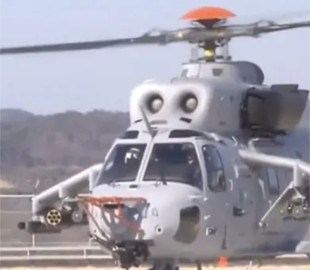
The helicopter looks like a machine from a cult film from the 1980s, especially in terms of weapons. The MAH is equipped with a three-barreled 20 mm cannon in the nose, as well as three mounting points on each wing for placing missile weapons.
South Korean aircraft manufacturers Korea Aerospace Industries (KAI) have developed a heavy attack helicopter MAH to support the Marine Corps. The machine has already made its first flight, which lasted about 20 minutes, during which such characteristics as maneuvering at low altitude, circular flight and maximum speed at an altitude of 30 meters were tested. The War Zone's observers told about the new KAI development.
The first thing the authors of the publication noticed was the striking external resemblance of the MAH to the helicopter from the cult 1980s film “Rambo”, namely to the modified Aerospatiale Puma, which played the role of the Soviet Mi-24 helicopter. The heavy armament of the South Korean helicopter, placed on relatively huge wings, stands out in particular, and this decision is not accidental.
The fact is that the MAH was the result of 18 years of development within the framework of the Korean Utility Helicopter (KUH) program. The machine continued the evolution of previous models, including the KUH-1 Surion, introduced in 2009 and put into service with the army of the Republic of Korea in 2012. The main difference of the new version is its heavy armament and optimization for maritime operations.
Key Features of the MAH
The MAH's main feature is its powerful armament, designed to support amphibious operations and close air combat. The helicopter is equipped with a three-barreled 20 mm cannon in the nose, as well as three mounting points on each wing for Cheongeom ATGM guided anti-tank missiles, MBDA Mistral air-to-air container missiles, and seven-charge unguided rocket launchers. An electro-optical and infrared turret complements the armament, providing high accuracy of guidance.
Additional systems, including missile attack warning sensors and laser sensors, enhance the crew's protection capabilities. The cockpit features fully integrated control systems, helmet-mounted displays, and night vision devices.
The MAH is powered by two T700-701K turboshaft engines, each with 1,855 hp, optimized by a full authority digital engine control (FADEC) system. The helicopter is also adapted to maritime conditions: it is equipped with folding blades and emergency landing facilities.
Observers note that the MAH has become part of an ambitious program to strengthen South Korea's amphibious capabilities. The helicopter is designed to accompany vehicles and perform strike missions from Dokdo-class landing ships. The first batch of 24 vehicles will be delivered in the coming years, which will allow for the formation of a full-fledged squadron.

